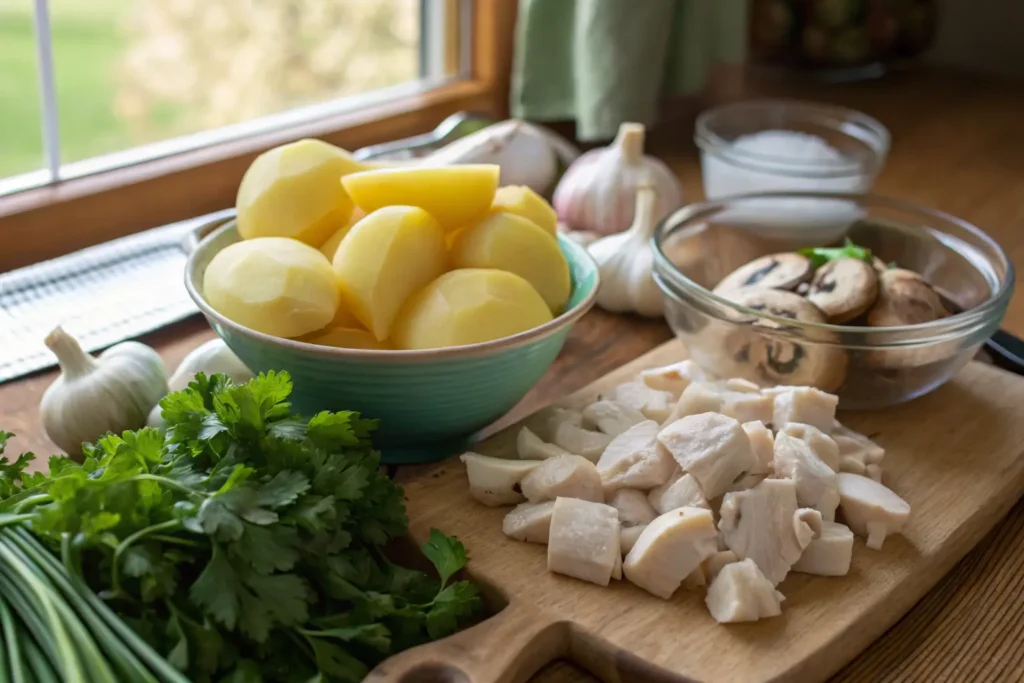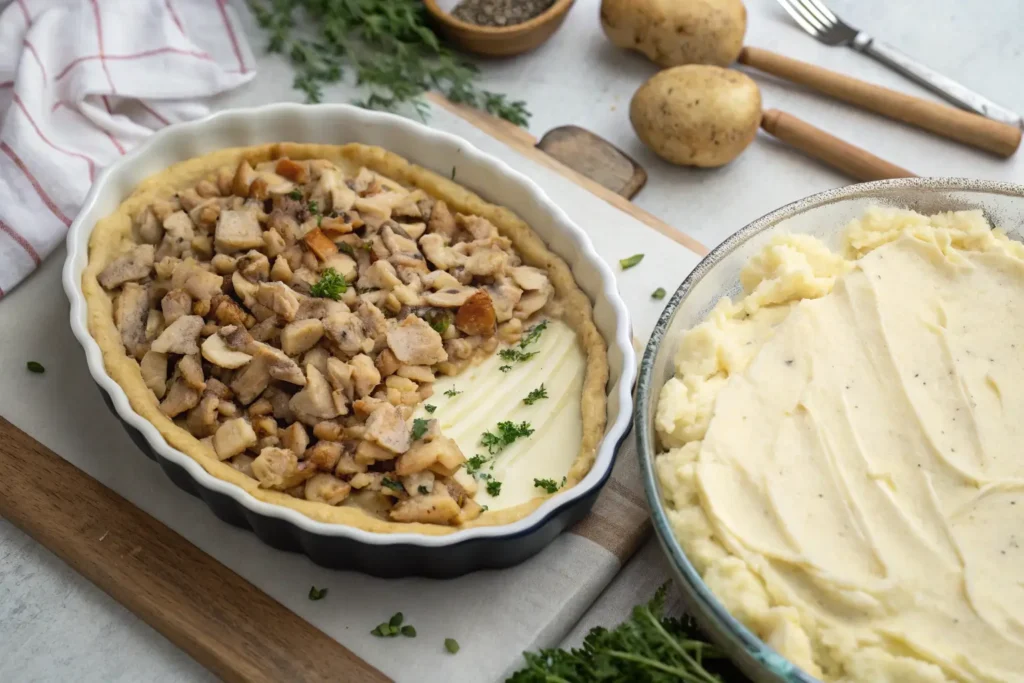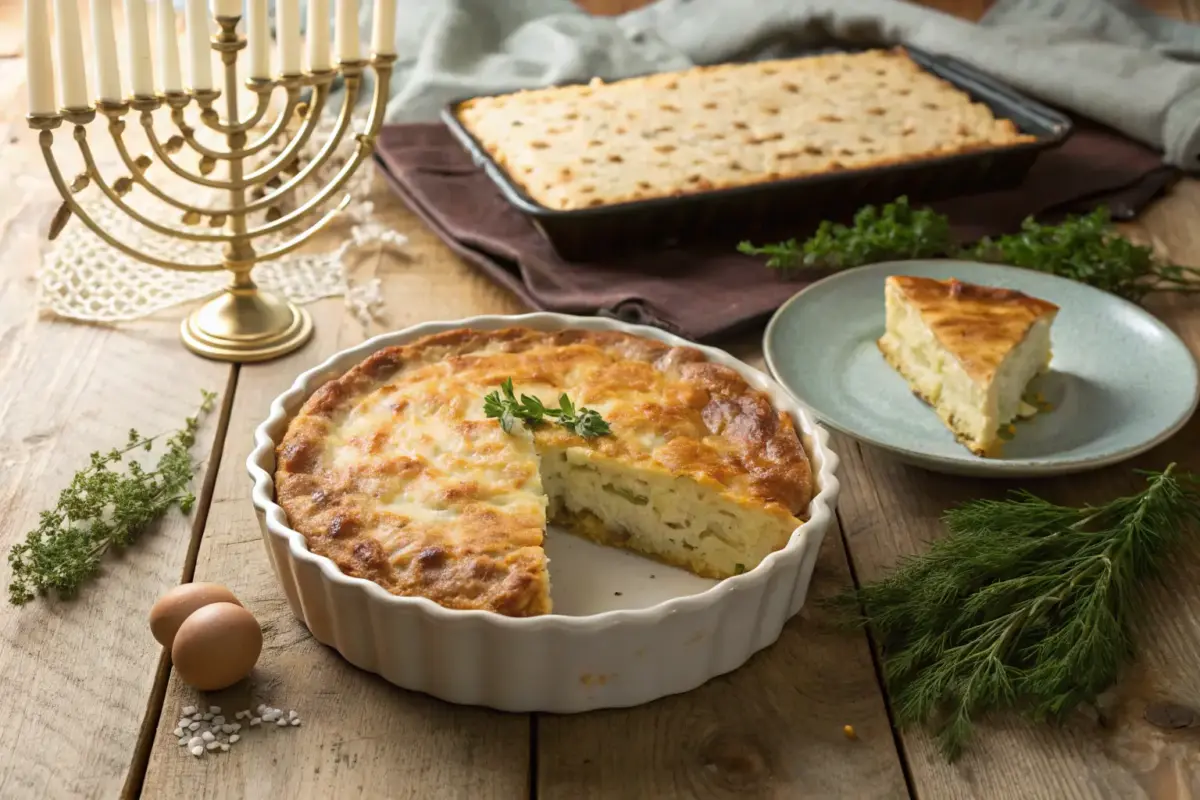Introduction to Passover Potato Pie
Passover Potato Pie is a comforting and traditional dish that holds a special place on holiday tables. With chametz (leavened grains) off-limits during Pesach, potatoes become a versatile ingredient, and this pie highlights their potential beautifully. Featuring a creamy mashed potato topping and a savory filling, it’s a dish that satisfies both the heart and the stomach. Beyond its deliciousness, Passover Potato Pie reflects the creativity of Jewish cuisine, adapting simple ingredients into something extraordinary. Whether you’re following time-honored recipes or putting your own spin on it, this pie is perfect for family gatherings or quiet celebrations. It’s no wonder it has become a favorite during Passover—easy to make, incredibly flavorful, and deeply tied to tradition. Let’s explore what makes this dish so special and how you can make it a centerpiece of your Pesach menu.
Significance of Passover Traditions in Jewish Cuisine
Food plays a central role in Jewish celebrations, and Passover is no exception. Each dish served during the holiday tells a story or honors a tradition, and Passover Potato Pie is no different. Because chametz (leavened bread) is off the menu during Pesach, creative alternatives like potato-based dishes become staples. This pie is a reflection of that ingenuity, offering a delicious way to adhere to dietary restrictions while celebrating heritage.
Why Potato Pie is a Pesach Favorite
What makes this dish a crowd-pleaser year after year? First off, it’s versatile. Whether you’re feeding a big family or preparing a cozy dinner, this pie adapts beautifully. Similar to dishes like Tortilla Quiche Bake, it combines familiar ingredients in a comforting format. It’s also packed with flavors and textures—creamy potatoes, savory chicken, and aromatic herbs all come together in harmony.
Ingredients for a Delicious Passover Potato Pie

Essential Ingredients for the Filling
The filling is where the magic starts. To keep things simple and authentic, you’ll need a mix of protein, vegetables, and seasonings that complement the star of the show—the potatoes. Here’s a quick rundown of the must-haves:
- Chicken: A protein-packed base that absorbs the flavors of the seasonings beautifully.
- Mushrooms: These add a rich, earthy taste that pairs perfectly with the other ingredients.
- Fresh herbs: Think parsley, dill, or thyme for a burst of freshness.
- Onions and garlic: The flavor foundation that ties everything together.
Chicken, Mushrooms, and Herbs Combination
Combining these ingredients creates a filling that’s savory and satisfying. The chicken is seasoned and cooked until tender, while the mushrooms add depth. Fresh herbs like parsley and dill brighten up the mixture, making it both hearty and refreshing.
Crafting the Perfect Potato Topping
Now, let’s talk about the topping. This is where the comfort factor really shines. For a traditional Passover Potato Pie, the potatoes need to be creamy, fluffy, and just a little crispy on top. Yukon Gold potatoes are a fantastic choice—they mash up like a dream and have a natural buttery flavor.
To create the topping, boil and mash the potatoes with a little salt, olive oil, and chicken stock (for a kosher twist). The goal is to make it smooth but firm enough to hold its shape when baked. For an added touch, brush the top with a bit of oil before baking to achieve that golden, slightly crispy finish.
Step-by-Step Preparation Guide
Preparing the Savory Chicken Filling
Start by cooking your onions and garlic in olive oil until they’re fragrant and golden. Next, add the chicken and let it cook until it’s tender and lightly browned. Toss in your sliced mushrooms and continue cooking until everything melds together. Don’t forget to season generously with salt, pepper, and your chosen herbs.
Mastering the Creamy Potato Topping
While the filling cools slightly, it’s time to work on the potatoes. After boiling them until fork-tender, drain and mash them with your seasonings and liquids. Taste as you go—you want it flavorful enough to stand out but not overpower the filling.
Assembling the Layers for Perfection

Here comes the fun part! Start by spreading the chicken and mushroom filling evenly in a greased baking dish. Then, layer the mashed potatoes on top, smoothing them out with a spatula. For a little flair, use a fork to create swirls or lines on the surface of the potatoes.
Baking Tips for a Golden-Brown Finish
Bake your pie in a preheated oven at 375°F for about 25–30 minutes. You’ll know it’s ready when the top is lightly golden and the edges are bubbling. If you’re feeling fancy, you can broil it for the last couple of minutes to get that perfect crispy crust!
Customizing Your Passover Potato Pie
If there’s one thing to love about Passover Potato Pie (besides how delicious it is), it’s how customizable it can be. Whether you want to switch up the ingredients or add something unexpected, there’s plenty of room for creativity. Let’s look at a few ways to make this dish your own!
Vegetarian Alternatives for the Filling
Not a fan of chicken or cooking for vegetarians? No problem! Swap out the chicken for hearty vegetables like roasted zucchini, eggplant, or even cauliflower. Another fantastic option is to use crumbled tofu or lentils, which add both protein and texture. By seasoning these substitutes well, you can create a filling that’s just as flavorful as the original.
Creative Add-Ins for Enhanced Flavor
Want to take your pie to the next level? Try mixing in some sautéed spinach or kale with the filling for a pop of color and extra nutrients. For a burst of sweetness, add caramelized onions or roasted carrots. And if you’re feeling adventurous, a pinch of smoked paprika or ground nutmeg can give the dish a whole new depth of flavor.
Pairing Suggestions
Now that your Passover Potato Pie is ready to impress, it’s time to think about what to serve alongside it. The right pairings can elevate your meal from great to unforgettable. Here are a few ideas to get you started.
Ideal Side Dishes to Complement Potato Pie
For a well-rounded meal, serve your pie with a crisp, fresh salad. Something simple like mixed greens with a lemon vinaigrette works beautifully to balance the richness of the pie. Another great option is roasted vegetables—think asparagus, carrots, or Brussels sprouts. Their earthy flavors play well with the creamy potatoes and savory filling.
Perfect Wine Pairings for the Occasion
Let’s not forget about the wine! If you’re a fan of reds, go for something light and fruity like a Pinot Noir. It won’t overpower the dish but will still bring out the savory notes. For white wine lovers, a crisp Sauvignon Blanc or a buttery Chardonnay makes an excellent match, especially if your filling includes mushrooms or herbs.
Storing and Reheating Tips For Passover Potato Pie
Leftovers? Lucky you! Passover Potato Pie stores and reheats wonderfully, which means you can enjoy it even after the holiday. Follow these tips to keep it tasting fresh and delicious.
Best Practices for Storing Leftovers
Before storing, let your pie cool completely. Then, cover it tightly with plastic wrap or transfer it to an airtight container. It will stay fresh in the fridge for up to three days. For longer storage, you can freeze individual portions wrapped in foil and placed in freezer bags. That way, you can grab a serving whenever the craving hits.
How to Reheat Without Losing Flavor
Reheating your pie is simple but requires a bit of care to keep it from drying out. If you’re using the oven, cover the dish with foil and bake at 350°F until heated through, about 15–20 minutes. For smaller portions, the microwave works fine—just add a splash of water or stock to maintain moisture. Pro tip: if you want to revive the crispy top, pop it under the broiler for a minute or two after reheating.
Nutritional Insights
Passover Potato Pie isn’t just a delicious dish; it’s also packed with nutritional benefits. By carefully choosing ingredients, you can enjoy a meal that’s both satisfying and wholesome. Let’s break it down.
Health Benefits of Key Ingredients
Potatoes are a great source of energy, thanks to their high carbohydrate content. They’re also rich in potassium, which helps with muscle function and maintaining healthy blood pressure. Adding chicken brings in lean protein, which is essential for building and repairing tissues. Mushrooms contribute fiber, vitamins, and antioxidants, making this dish a nutritious powerhouse.
Balancing Tradition with Nutrition
It’s easy to make this dish a bit healthier without sacrificing tradition. For instance, swap out heavy oils for olive oil or try reducing the amount of salt by using fresh herbs for flavor. If you’re watching your carb intake, consider using sweet potatoes or a mix of vegetables as an alternative topping.
Passover Potato Pie Around the World
While Passover Potato Pie might feel like a quintessentially Jewish dish, it has variations and cousins in cuisines around the world. These regional twists add even more depth to its cultural significance.
Regional Variations and Unique Twists
In Sephardic Jewish communities, a dish called Maakouda is popular during Passover. This North African potato pie often includes eggs and spices like cumin, giving it a distinct flavor profile. Meanwhile, in Eastern European Jewish households, dishes like potato kugel share similarities, though kugel often uses shredded potatoes for a crispier texture. Each variation tells a story of how Jewish communities adapted recipes based on local ingredients and traditions.
FAQs About Passover Potato Pie Dishes
Can Jews eat potatoes during Passover?
Yes, potatoes are a staple during Passover. Since chametz (leavened grains) is not allowed, potatoes and other non-grain starches like sweet potatoes and yams become essential in recipes. They’re versatile, kosher for Passover, and an important part of many traditional dishes.
Can you eat kugel on Passover?
Absolutely! Potato kugel is a Passover favorite. However, it must be made without chametz, which means using ingredients like potatoes, eggs, and kosher-for-Passover seasonings. For those who prefer sweet kugels, matzo farfel or other substitutes can replace the noodles used in non-Passover versions.
What is a substitute for matzo meal in potato kugel?
If you’re out of matzo meal or looking for an alternative, you can use ground-up matzo crackers or even potato starch as a substitute. Both options help bind the kugel while keeping it kosher for Passover.
What is the history of the Maakouda?
Maakouda is a traditional North African potato pie enjoyed by Sephardic Jewish communities during Passover and year-round. Its origins can be traced to Morocco, where it was often served as a street food. During Passover, it became a popular dish because it’s naturally chametz-free and easy to adapt for kosher requirements. Over time, it has found a place on holiday tables as a comforting and flavorful dish.
Conclusion : Passover Potato Pie
Celebrating Passover with Culinary Delight
Passover Potato Pie is more than just a recipe—it’s a celebration of tradition, family, and the art of cooking with care. Whether you stick to the classic version or get creative with your own twists, this dish is sure to bring joy to your holiday table. With its rich flavors, meaningful history, and endless possibilities, it’s no wonder this pie has become a Pesach favorite. So gather your ingredients, preheat that oven, and enjoy every bite of this delicious tradition!


2 thoughts on “Passover Potato Pie Recipe: A Holiday Favorite”